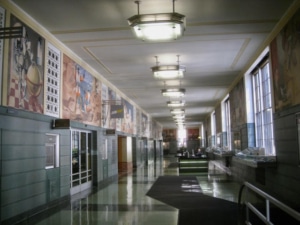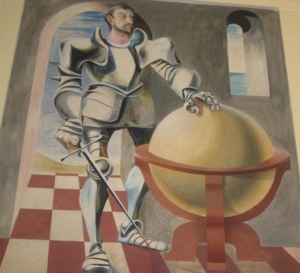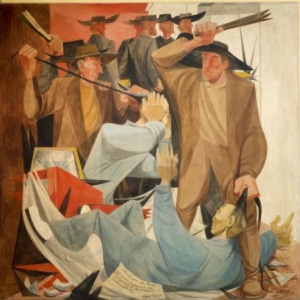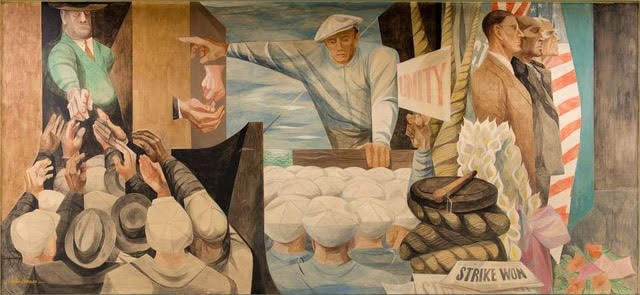
Refregier’s mural series, “History of San Francisco,” at Rincon Annex, former post office in San Francisco. The murals, painted between 1941 and 1948, challenged traditional views of America. (Photo: Gray Brechin)
The New Deal federal art projects never received the popular support Roosevelt himself enjoyed as president. FDR created them by executive fiat, leaving representatives in Congress to deal with their irate constituents when artists went astray. Nor did George Biddle help. The president’s aristocratic Groton classmate—himself an artist largely responsible for the establishment of the federal art projects—enjoyed needling powerful domestic opponents: “The most serious threat to the success of life of the Project,” he wrote after much experience,
is the high emotional level and the low mental caliber of our Congressmen.
Prior to the 1929 stock market crash, virtually all public art had endorsed the benignity and legitimacy of the American Dream.Prior to the 1929 stock market crash, virtually all public art had endorsed the benignity and legitimacy of the American Dream, often using allegorical figures of Progress, Abundance, and Justice. No market existed for artists who might question it. But in 1934, the depths of the Great Depression, Roosevelt opened a window for those artists who might dissent, giving them both patronage and exhibition space without precedent in the United States.
Of the art bureaucracies that followed the short-lived Public Works of Art Project, the Treasury Section of Painting and Sculpture, known simply as “the Section,” offered the most prestigious and lucrative commissions. Created by executive order of Treasury Secretary Henry Morgenthau on October 14, 1934, the Section was designed to ensure high-caliber work in public buildings by selecting artists in juried competitions. In 1940 a Section jury chose Anton Refregier, a Russian immigrant living in Woodstock, New York from among 82 contestants to decorate a new post office in San Francisco. The government agreed to pay Refregier $26,000 to design and paint a chronological history of the city in 27 panels. A delighted Refregier told reporters that he had worked five months preparing his designs. What he did not tell them was that he would paint unconventional episodes that the city’s fathers and newspapers wished deleted from the record.

Explorer Sir Frances Drake landed in California in 1579, claiming the land for Queen Elizabeth of England. Refregier painted Drake with a bloodied sword. (Photo: Gray Brechin)
A strong-minded outsider, Refregier also told the San Francisco Chronicle that he wanted to paint the past not as a romantic pageant but as part of the living present—a present shaped by the trauma of the Depression, strikes and impending war. World War II, however, interrupted the Rincon Annex project, while Roosevelt’s death virtually ended this brief experiment in federal patronage. By the time Refregier returned to San Francisco in 1946, the Truman administration was phasing out the Section. Responsibility for its outstanding projects was transferred to the Public Buildings Administration. Under its aegis, Refrigier began painting the panels whose subject matter grew ever more provocative as they approached current events.
Refregier painted scenes of racial, class and ideological conflict: a Vigilante lynching, anti-Chinese riots, the 1934 Maritime Strike and the Allies united against Nazi atrocities. During the heightened controversy over his murals shortly after he completed them in 1948, the artist noted his fears for what he considered his masterpiece:
Some night, perhaps, men will come with buckets of white paint and it will take very little time to destroy that which took me so long to make. And in the morning it will be just like it was three years ago. White walls without colors, without ideas, ideas that make some people so mad and so afraid.
Congressmen who admitted they had not seen the murals nonetheless decried them for inciting class hatred and violence as well as historical inaccuracy. They wanted the murals destroyed as a prelude to a campaign against other “un-American” art. On the morning of May 1, 1953, the House Committee on Public Works convened in Washington, DC to debate the destruction of one of the largest and most expensive artworks ever commissioned by the federal government. Refregier, according to Republican Representative Hubert Scudder of Sebastopol, California, had foisted upon the American taxpayer propaganda designed to slander the state’s pioneers and convert patrons at San Francisco’s main post office to communism.

“Beating the Chinese,” depicting ethnic violence against Chinese immigrants at the San Francisco “sand lot” riot of 1877.
Photo, Carol M. Highsmith. (Photo: Library of Congress)
In its daylong deliberations, the committee put history, as well as art, on trial. During the trial, Refregier anxiously kept in touch with his attorney from his studio in Woodstock. His art was ably defended by Congressmen of both parties, scholars and the directors of leading museums in San Francisco and New York City and even by Julian Huxley, the former director of UNESCO who decried calls for censorship in the U.S.
Five weeks after the congressional hearing, the California Senate voted overwhelmingly to urge Congress to destroy the Rincon murals. Nevertheless, Rep. Scudder’s motion never made it out of committee. The murals stayed and today rank high among San Francisco’s many artistic treasures. Few realize that they once represented a bulwark in defense of other New Deal artworks around the U.S. that might otherwise have been erased.

